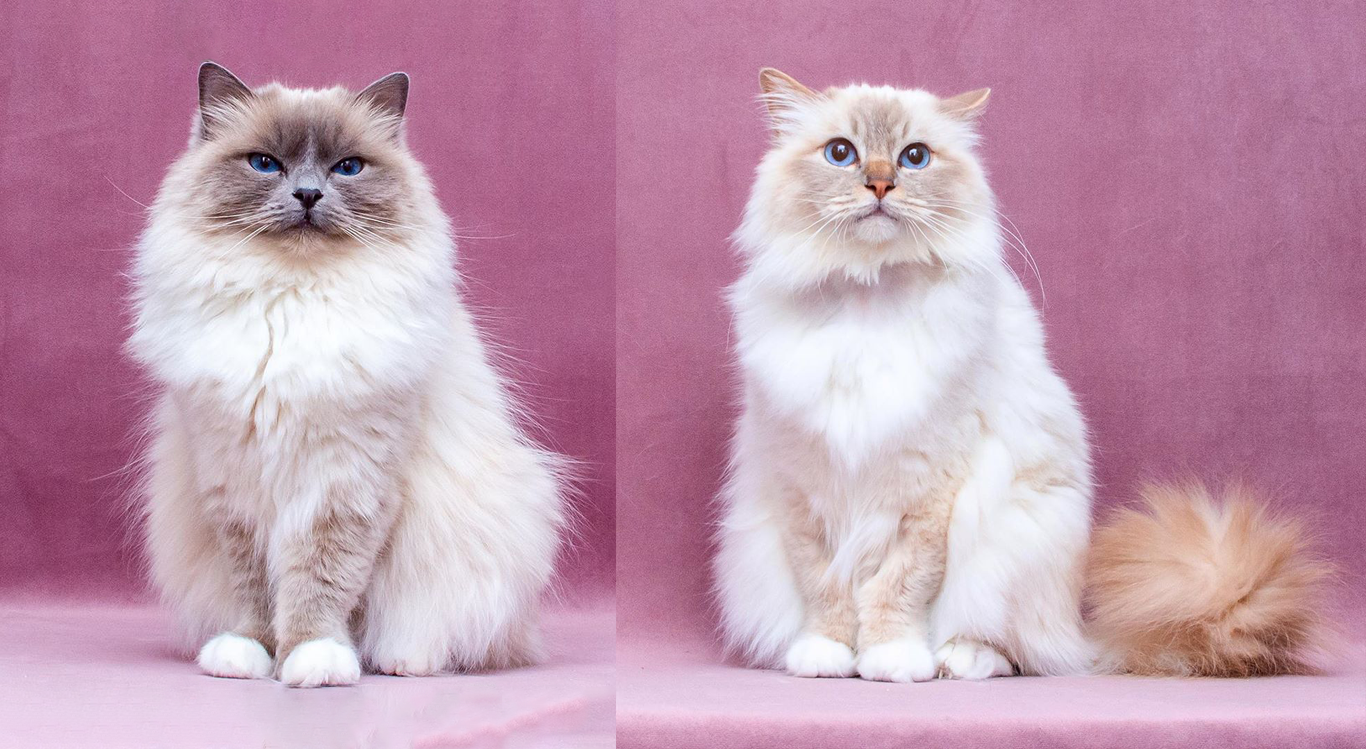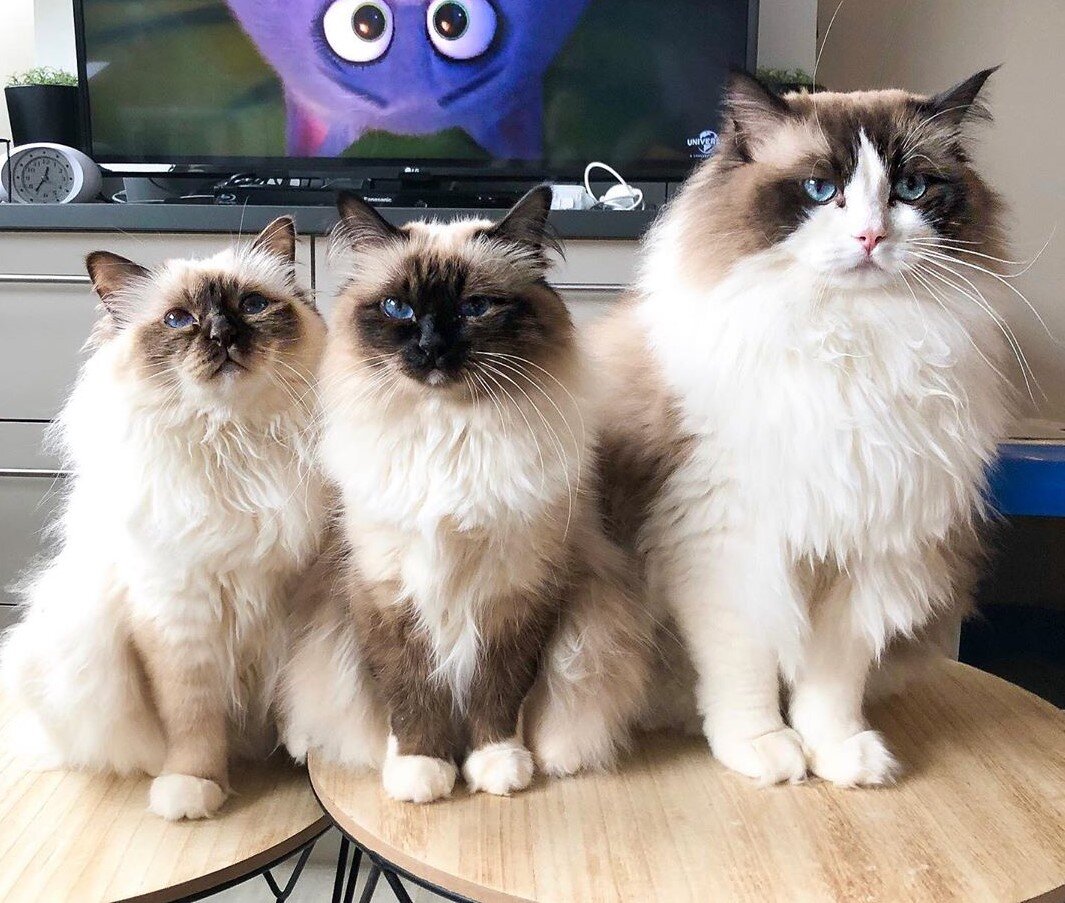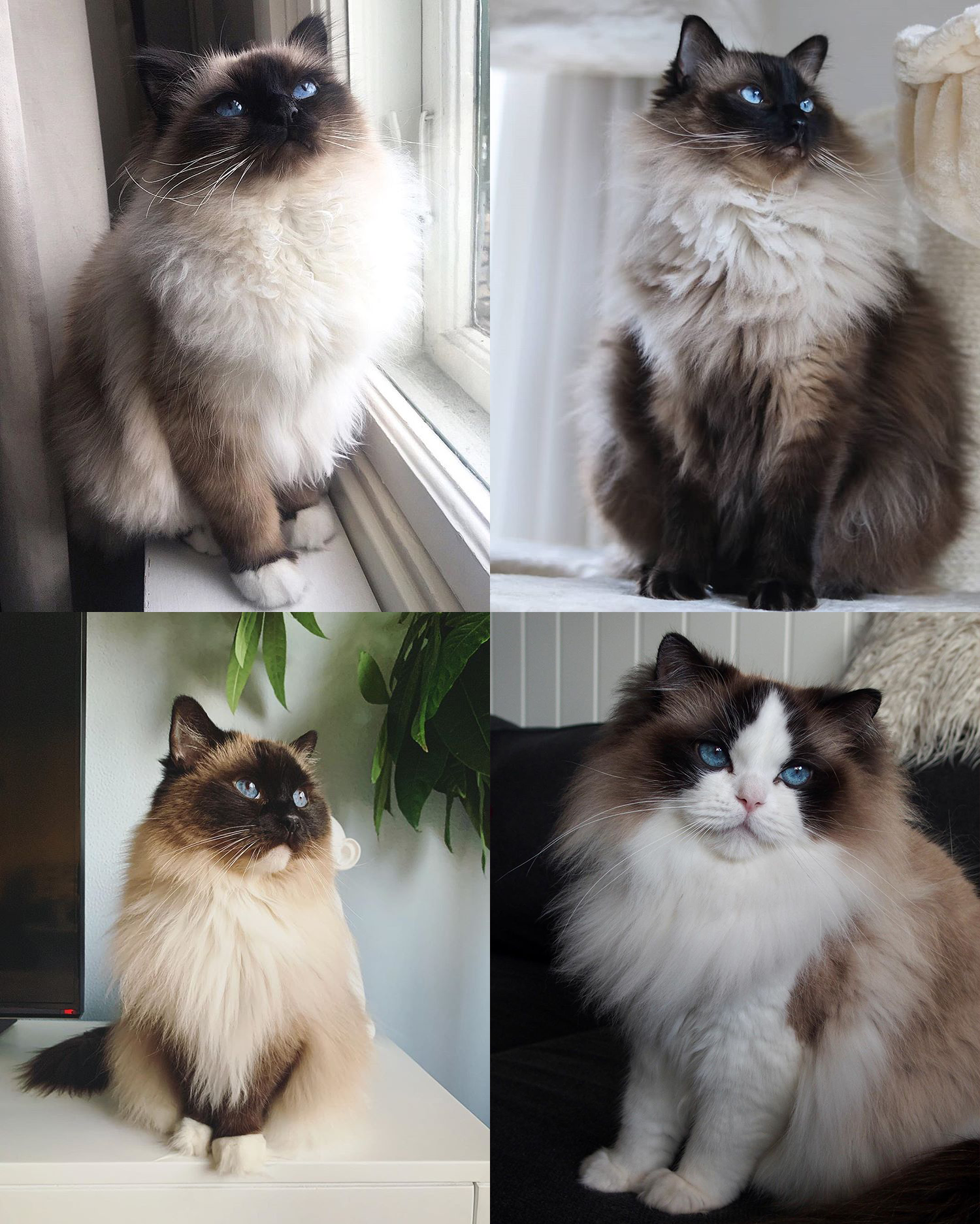Birman vs Ragdoll
Ragdoll and Birman are two cat breeds that look quite similar and are often confused. I myself wasn’t able to recognize them before doing some research for this article. You’ll see that, with a few tips, telling the two breeds apart will be easier!
Disclaimer: The following tips will only help you to visually recognize the two breeds, but the only way to know for sure if a cat is a Birman or a Ragdoll is to check the cat’s pedigree!
So, if your cat matches some of these criteria, it does not necessarily make it a Birman or a Ragdoll! It needs to have a pedigree that proves its breed.
If you are hesitating between acquiring a Birman or a Ragdoll kitten, I highly recommend that you read about ethical breeding.
Breed History
The origins of the Birman
The Birmans or 'Sacred Cats of Burma' have a legendary origin. These cats were raised by the Kittah priests in their temple in Burma. The legend says that they got their blue eyes from the worshipped goddess who also had sapphire blue eyes. The white paws were awarded as a symbol of purity for their devotion.
The Birmans are said to be the descendant of a pair of cats which were brought back from a temple in Burma to France in the 1920s. Reports of the breed were made in 1927 by the Cat Club de France. However, the breed was almost entirely wiped out during the Second World War and was recreated from two purebred Birmans, with the addition of Persian and Siamese blood. The breed was recognized in 1949 by the Fifé, it was then exported outside of France and recognized in the US and UK in the ’60s.
From left to right, a blue point Birman and a lilac tabby point Birman from @suzannes
The origins of the Ragdoll
Like for the Birman, there are a lot of myths about the origins of the Ragdoll breed. What’s for sure is that this breed was created by Ann Baker in the 1960s from one cat called Josephine. Josephine was a white cat of Persian type and the legend says that after a car crash, Josephine began to have a particularly loving personality, and a tendency to limp when she was picked up. The legend even says that she and her babies lost the ability to feel the pain which is, of course, false! Because of these character traits, Ann Baker decided to selectively breed Josephine to produce more cats with those traits. She named the breed Ragdoll, referring to the cat tendency to go limp like a stuffed doll. Ann Baker trademarked the name Ragdoll and for a long time, the cat could be registered only in her own registry.
Finally, in the 80s, some of the cats were exported to Europe and the Ragdoll breed started being recognized in most of the major cat registries. The breed was recognized by the GCCF and the Fifé in 1991.
Birman blood has been used to create the Ragdoll breed, hence the similarity between these two breeds.
From left to right, a blue mitted Ragdoll and a seal tabby mitted Ragdoll from @twocanadianragdolls
Physical features
Ragdolls and Birmans share most of their physical features: both breeds have a long fur, medium-sized ears with a rounded tip, their face shape is a rounded triangle, a medium-length muzzle, they both have a long and well-muscled body, with a good bone structure.
However, there are some physical differences that help to tell apart one breed from another.
Eyes
Ragdolls have large oval eyes, while Birmans have rounded, medium-sized eyes.
Fur
The Birman has a silky fur, with almost no undercoat, while the Ragdoll has a soft and plushy fur.
Tail
The Birman tail has a medium length, the Ragdoll tail is long.
From left to right, a chocolate point Birman, a seal point Birman and a seal bicolor Ragdoll from @ladylolathecat
Size
The Ragdoll is a large and slow to mature cat. An adult male can weigh 6 to 9 kg (12 to 20 pounds) and the females can weigh around 4 to 6kg (8 to 15 pounds).
The Birman is a medium-sized cat that weighs around 3 to 6 kg (6 to 12 pounds) for an adult male, with the females being a bit smaller.
Profile
The Ragdoll nose has a gentle curve, while the Birman nose has a slight indentation and is roman in shape.
On the left a lilac point Birman from @irmathebirman and on the right a blue mitted Ragdoll from @chuckbass_gossipcat
The two breeds don’t share all their physical features, but most of these differences can be quite difficult to see for the untrained eye. The good news is that the best way to recognize a Birman from a Ragdoll is by looking at their coat!
Coat color and patterns
Both breeds are colorpoint, which means that only their extremities are colored and their eyes are blue. The face, ears, feet, and tail are therefore darker than the rest of the body. The body should stay clearer in the Birman when compared to a Ragdoll.
In term of colors, both breeds are again similar: the seal (black), blue, chocolate and lilac, red and cream are all allowed colors for both Birmans and Ragdolls, and some cat registries even allow the cinnamon and fawn colors.
Both breeds may also have the tabby markings. The smoke and silver are only allowed in the Birman breed, with some exceptions for some cat registries which allow them also for Ragdolls.
You’re probably going to think that all this doesn’t really help to tell them apart. And you would be right: the main difference between the two breeds is in their white pattern!
A lilac tabby point Birman (top left), a chocolate tabby point Birman (top right) and a seal tabby point Birman (bottom) from @bennyy_and_nala
Birman
The Birmans are mitted, and this is one of the main characteristics of the breed. It means that they have white “gloves” on their paws. The white must cover entirely the toes and stop at the joints. On the back legs, the white should go further up and finish in an inverted V. The white markings should be symmetrical. Any other white spot is forbidden on the body.
The gene mutation responsible for the mitted pattern in the Birman breed is identified and can be genetically tested. All Birmans should be homozygous to the mutation.
Inverted V on the back leg of a Birman from @bennyy_and_nala
Ragdoll
Three patterns exist for the Ragdoll breed: colorpoint, mitted and bicolor. (In some pedigrees, the Van or High-White pattern is recognized).
Colorpoint
The ragdoll doesn’t have any white spots. It is therefore easy to tell apart from a Birman. Just look at the paws: if they are not white, it’s a Ragdoll.
Mitted
The Ragdoll may have white gloves like the Birman! How do you tell them apart then? When the Ragdoll is mitted, its chin should also be white, contrary to the Birman which has a colored chin. In fact, the mitted Ragdoll must have a white band going from its chin, through its belly, and up to the tail. A narrow white marking is allowed on the nose.
Some Ragdolls have the Birman white gloving mutation, but not all of them, meaning that it’s another genetic mechanism responsible of the white mitted pattern in the Ragdoll.
Bicolor
It’s the classical coloring of the Ragdoll where the cat has an inverted V on his face. The legs, chest, and belly are white. The inverted V should not extend beyond the eyes’ extremities. This pattern is useful to recognize a Ragdoll, as the Birman doesn’t have any white on its face.
Top left: Seal point Birman from @jawothecat
Top right: Seal point Ragdoll from @ragdollgino
Bottom left: Seal mitted Ragdoll from @hillywood_dolls
Bottom right: Seal bicolor Ragdoll from @soldolls
Warning
The criteria I presented are the ideal ones, which are described by the standards. However, nature happens and not all Ragdolls and Birmans are “standard perfect”: take this into account when you see a picture of a cat!
Moreover, some clear colors such as dilute colors, red, or for tabby colors, the chin of the Birmans can appear white.
Character
Ragdolls are known to be a relaxed and loving breed, that is tolerant with other animals and children. Many Ragdolls will go limp when you hold them, like the stuffed doll they take their name from.
The Birman is also a calm breed and adapted to family life.
However, while it’s true that cats of a same breed may have similar traits, each cat has its own personality. That’s why I don’t think it makes a lot of sense to compare the characters of the two breeds.
To summarize, Ragdolls are much bigger than Birmans. Most of the differences between the two breeds lie in the white patterns: if there are no white spots, what you’re looking at is probably a Ragdoll; if instead, the cat has white gloves and a colored chin it’s likely a Birman; if there are both the gloves and a white chin, it’s a Ragdoll and, finally, if there is white on the face it’s a Ragdoll!
I hope this article was helpful and that you will now be able to recognize these two breeds.
Sources
Title picture: On the left, a lilac point Birman from @irmathebirman and on the right a blue bicolor Ragdoll from @ragdollgino
Standard LOOF
Standard FIFé
Standard TICA
Other readings
My complete guide to raw feeding!
Get a balanced and personalized recipe to feed your cat a healthy homemade diet!
Maine Coon vs Norwegian Forest cat, what are the differences?






